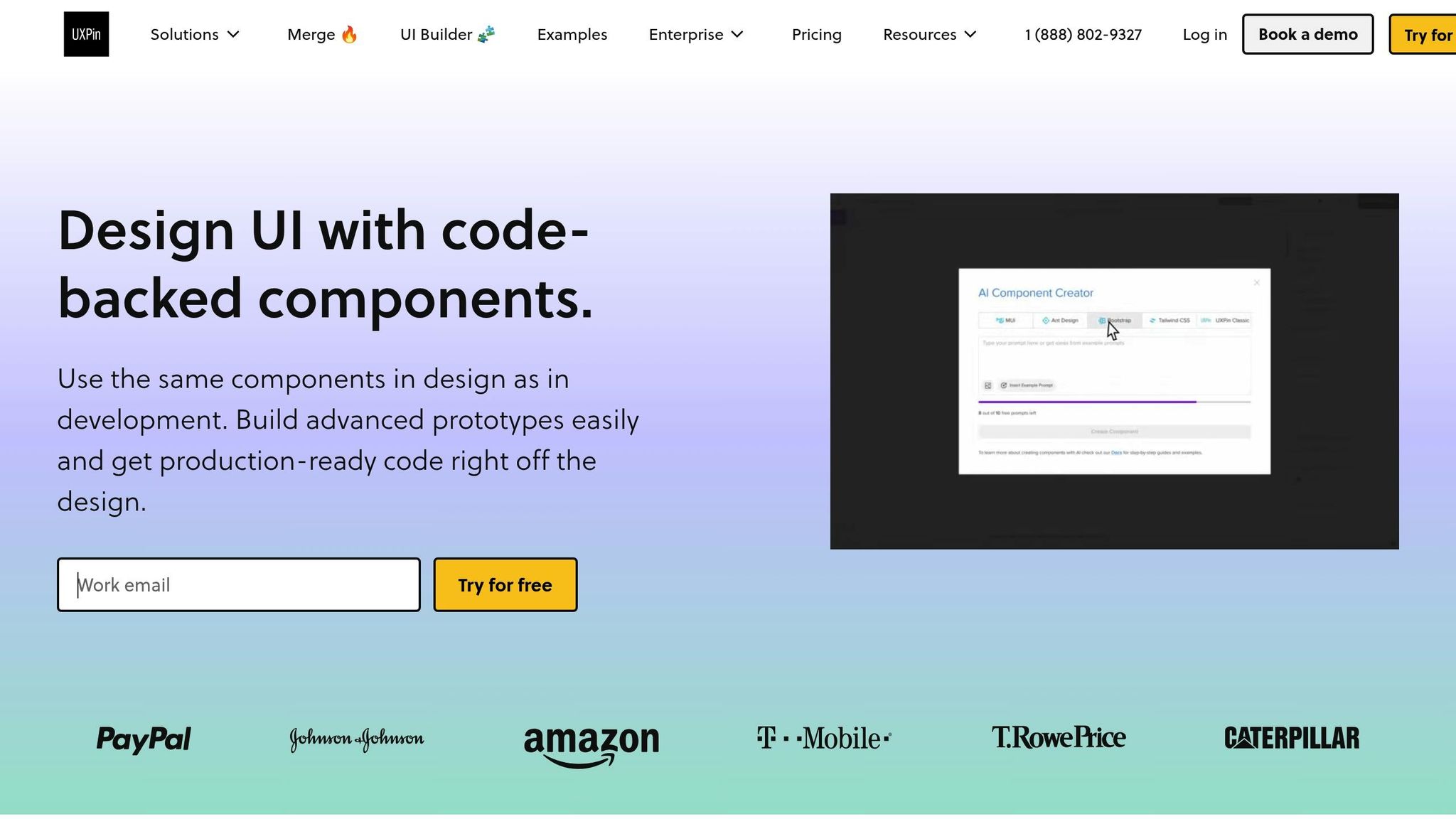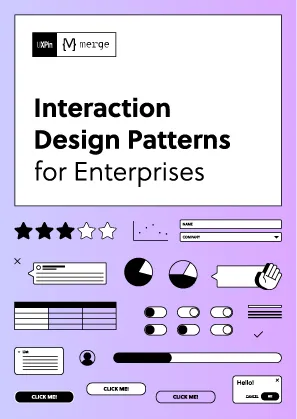27% of adults in the U.S. live with a disability, yet 96% of top websites have accessibility issues. Real-time accessibility tools solve this by integrating checks during design, making digital content easier for everyone to use. Here’s why they matter:
- Fix Issues Early: These tools flag accessibility problems during design, saving time and money compared to fixing them later.
- Automated WCAG Checks: Ensure compliance with accessibility standards (WCAG 2.0, 2.1, 2.2) and legal requirements like ADA Title III.
- Interactive Testing: Test dynamic content, like buttons and forms, to ensure functionality with assistive technologies.
- Color Contrast & ARIA Labels: Tools like UXPin provide real-time contrast checks and ARIA label testing for screen readers.
Why it matters: Accessible design benefits everyone, improving usability, task completion rates, and customer satisfaction. And it’s good for business – companies focusing on accessibility report 1.6x higher revenue.
Main Features of Live Accessibility Tools
Instant Feedback for Quick Problem Fixing
One standout feature of live accessibility tools is their ability to deliver real-time feedback during the design process. Instead of uncovering issues weeks or months later, these tools flag accessibility problems as they occur. This immediate insight allows teams to address concerns right away, while the design is still fresh in their minds.
With live feedback, teams can focus on resolving the most impactful issues first. This ensures that each design iteration is shaped by actual user needs rather than assumptions .
Automatic WCAG Standard Checks
Beyond instant feedback, live accessibility tools also automate compliance checks against established accessibility guidelines. These tools scan designs to ensure they align with WCAG 2.0, 2.1, and 2.2 standards, as recommended by the W3C. They also verify compliance with related legal requirements . This automation removes the guesswork from meeting accessibility standards and saves teams from the burden of manual checks.
Understanding these guidelines is crucial for both design integrity and legal compliance. For example, ADA Title III requires private websites in the U.S. to follow WCAG 2.2, while Section 508 mandates that government websites meet WCAG 2.0 standards. Similarly, the European Accessibility Act sets a deadline of June 28, 2025, for private websites in Europe to ensure accessibility.
"ADA Title III is not a set of standards, it’s US-based legislation, enforcing private websites to comply with the WCAG 2.2 Accessibility Guidelines." – AccessibilityChecker.org
By automating these checks, live tools help eliminate human error, allowing designers to focus on creating user-friendly experiences.
Testing Interactive Content and Components
Interactive content, such as dynamic elements, poses unique challenges that static testing often overlooks. Live accessibility tools tackle this by testing these components in real time as users interact with them. This ensures that ARIA roles and properties are implemented correctly and that interactive elements meet accessibility standards .
Dynamic content is particularly important because it can be a source of significant accessibility failures. Globally, 16% of people live with disabilities, making inclusive design a necessity . Interactive elements, by their nature, can change based on user actions, which adds complexity to accessibility testing.
These tools help ensure that interactive content works as intended by verifying features like keyboard navigation patterns, color contrast across different states, and screen reader compatibility. They also document best practices for combining components to maintain accessibility in complex interfaces.
"Good accessible design often leads to better aesthetics overall. Simple, clear layouts with proper spacing and hierarchy tend to look more polished than cluttered, complex designs." – Andrée Lange, Digital Designer at Level Level & Trainer at The A11Y Collective
How Live Accessibility Tools Improve User Experience
Making Products Easier to Use for Everyone
Real-time accessibility tools make digital products easier and more intuitive for all users by addressing usability issues early on. Features like clear navigation, proper color contrast, and well-structured content create smoother online experiences, benefiting everyone – not just those with disabilities.
The reach of these tools goes far beyond meeting compliance standards. Around 15% of the global population lives with a disability, and 2.5 billion people rely on assistive technology to navigate the web. Accessibility improvements also help people in temporary situations – like someone struggling to see their screen in bright sunlight or a busy parent needing efficient keyboard shortcuts while multitasking.
"Universal Design is not a special requirement for the few but a quality requirement for the many. When we design for disability, we all benefit." – Microsoft Design Team
Despite this, accessibility issues remain widespread. For example, 94.8% of homepages had WCAG 2.0 failures as of March 2025. Live accessibility tools help address these gaps by identifying and fixing problems before they affect users. This ties back to the importance of integrating accessibility checks during the design phase, which naturally reduces the accumulation of issues over time.
Preventing Accessibility Problems from Building Up
Think of live accessibility tools as an early warning system for potential issues. Accessibility problems, if left unchecked, can pile up and lead to "technical debt" – making them harder and more expensive to fix later. By flagging these issues during the design process, teams can address them while the fixes are still simple and cost-effective.
This proactive approach saves both time and money while ensuring a better user experience from the start. Catching and resolving issues early prevents costly redesigns or post-launch fixes. It also helps maintain consistency, as designers can address accessibility concerns immediately, seamlessly integrating them into their workflow.
Helping Users Complete Tasks and Feel Satisfied
When accessibility is prioritized from the beginning, users benefit from a more satisfying experience. Digital products need to empower users to complete their tasks efficiently, and live accessibility tools make this possible by removing barriers that might otherwise hinder navigation or interaction. As a result, task completion rates improve across all user groups.
For example, a SaaS company that revamped its dashboard with a cleaner layout, modern typography, and consistent colors reported a 30% increase in task completion rates and user satisfaction. Additionally, as of 2024, 72% of organizations have adopted digital accessibility policies, recognizing that inclusive design helps them reach broader audiences. On top of that, 33% of global consumers prefer to support brands that align with their social or environmental values, proving that accessibility offers a competitive edge.
Live accessibility tools provide immediate, actionable feedback, ensuring that designs meet standards and help users complete tasks with ease.
"Accessibility is not just about legal checklists. It is about people. When you make your digital products accessible, you make the online world fairer and more usable for everyone." – Nitin Lahoti, Co-Founder and Director at Mobisoft Infotech
Accessibility Testing Tools To Know | Web A11Y Tools
sbb-itb-f6354c6
UXPin‘s Accessibility Features in Action

UXPin takes a unique approach to accessibility by using actual code to render components, enabling real-time, code-level accessibility testing. Unlike image-based design tools, UXPin integrates testing directly into the design process, providing accurate feedback without interrupting creativity. This seamless integration ensures that accessibility is considered at every stage of the workflow.
"It is a duty of designers to make digital spaces accessible for all people." – Marcin Treder, CEO at UXPin
By embedding accessibility checks into the design process, UXPin empowers designers to create inclusive user experiences while maintaining efficiency.
Testing Individual Components for Accessibility
One standout feature of UXPin is its ability to test individual components for accessibility compliance. Since UXPin uses React components and code-backed prototypes, designers can evaluate buttons, form fields, navigation menus, and other interactive elements in isolation.
This targeted testing allows teams to build a library of accessible components that can be reused across multiple projects. Once a component passes accessibility checks, it can be confidently deployed without risking compliance issues down the line.
By testing accessibility properties like focus states, keyboard navigation, and screen reader compatibility within the same code developers will use, UXPin bridges the gap between design and development. This ensures accessibility features function as expected in the final product.
Testing Color Contrast While You Design
Color accessibility is a critical aspect of inclusive design, especially considering that over 1.3 billion people live with some form of vision impairment and 4.5% of the global population experiences color blindness. UXPin tackles this challenge with built-in tools that check color contrast as designers work.
The platform’s contrast checker evaluates text and background color combinations against WCAG standards in real-time. Designers can choose to comply with either AA or AAA standards, and the tool flags insufficient contrast ratios as they occur.
"In our design editor you can specify whether you want to comply with AA and AAA standards. It’ll automatically inform you whenever the contrast is insufficient." – Marcin Treder, CEO at UXPin
Additionally, UXPin includes a color blindness simulator, which allows designers to test their interfaces against various types of color vision deficiencies. This ensures that visual elements remain accessible and information is clear, regardless of how users perceive color.
Testing ARIA Labels for Interactive Elements
Accessibility goes beyond visual adjustments – accurate ARIA labels are essential for making interactive components usable for everyone. UXPin’s code-based design approach lets designers work directly with ARIA attributes, ensuring proper labeling and functionality before development even begins.
In UXPin, designers can assign and test ARIA labels, roles, and properties within the design environment. This means interactive elements like buttons, form controls, and navigation menus can be labeled correctly and tested for compatibility with assistive technologies.
The integration with React component libraries ensures consistent handling of ARIA attributes across interface elements. Designers can verify that screen readers will accurately announce button functions, form field requirements, error messages, and navigation options.
"UXPin simplifies ARIA labeling, allowing designers to focus on creating inclusive experiences." – UXPin
Because the testing is based on actual code rather than static mockups, the results provide a more reliable prediction of how assistive technologies will interact with the final product. This makes UXPin a powerful tool for building truly inclusive designs.
Conclusion: Better UX Through Accessible Design
Real-time accessibility tools are changing the game when it comes to designing for inclusivity. By embedding accessibility checks directly into the design workflow, these tools shift accessibility from being an afterthought to a key part of user experience strategies. What used to feel like a compliance task now becomes a chance to enhance design and create a better experience for everyone.
Main Benefits
Live accessibility feedback brings two major advantages: it boosts user engagement and cuts costs. With 16% of the global population experiencing significant disabilities, accessible design opens up your product to a much broader audience.
From a user perspective, the impact is clear. Studies show that nearly 75% of users with disabilities will leave a website if it’s not accessible. Real-time tools help catch these issues early, preventing user frustration and abandonment. The payoff? Better customer engagement, a wider audience reach, and stronger brand loyalty.
On the financial side, early accessibility testing can save big. Fixing issues during the design phase is far cheaper than retrofitting them later. This "shift-left" approach lets engineering teams focus on innovation instead of scrambling to fix bugs.
And it’s not just about users with disabilities. Accessible design enhances the experience for everyone. Digital designer Andrée Lange sums it up well:
"Good accessible design often leads to better aesthetics overall. Simple, clear layouts with proper spacing and hierarchy tend to look more polished than cluttered, complex designs."
These benefits make a strong case for integrating accessibility into the design process from the start.
Building Accessibility into Your Design Process
Using real-time accessibility tools can make the process of creating inclusive designs smoother and more efficient. Tools like those in UXPin provide instant feedback without interrupting the creative flow, making it easier to build accessibility into every step of the workflow.
The real key, though, is fostering a team-wide commitment to accessibility. Catherine Nichols, Salesforce Chief Accessibility Officer, puts it perfectly:
"True accessibility requires more than checking a box. It demands ongoing commitment, a proactive mindset, and collaboration across teams. From engineering and design to policy and customer experience, accessibility is a shared responsibility and an opportunity to break cycles of digital exclusion."
To make this happen, start by incorporating accessibility checks throughout the design process and involving users with disabilities for real-world feedback. Use design systems that include accessibility standards for consistency, and keep updating your accessibility features as technology evolves.
Accessibility guidelines like WCAG provide a solid foundation, and real-time tools make it easier to follow them. With over 96% of the world’s most popular websites still inaccessible to people with disabilities, there’s an urgent need – and a huge opportunity – for change.
Inclusive design doesn’t just improve accessibility; it redefines what great user experience can be. With real-time accessibility tools, integrating inclusivity into the creative process becomes second nature. And when accessibility becomes seamless, everyone benefits.
FAQs
How do real-time accessibility tools enhance the UX design process?
Real-time accessibility tools significantly enhance the UX design process by offering immediate insights into potential accessibility challenges. These might include issues like low color contrast, missing alt text, or difficult navigation. Catching and fixing these problems early – right in the design phase – helps save both time and resources.
When accessibility checks are seamlessly integrated into the workflow, inclusivity becomes a natural part of the design process. This forward-thinking method not only makes digital experiences more user-friendly for everyone but also promotes smoother collaboration between teams. The result? Faster iterations and more effective designs that work for a broader audience.
How do real-time accessibility tools enhance user experience compared to traditional testing methods?
Real-time accessibility tools are game-changers when it comes to improving user experience. By offering instant feedback during the design process, they allow designers to catch and address accessibility issues right away. This eliminates the need to wait for a separate testing phase, streamlining workflows and enabling faster, more efficient iterations.
Many of these tools leverage AI and machine learning to identify a wide array of accessibility challenges, ensuring designs are more inclusive from the start. Since they integrate directly into design platforms, teams can effortlessly stay aligned with accessibility standards, creating digital experiences that work better for everyone.
How do real-time accessibility tools boost customer satisfaction and business success?
Real-time accessibility tools are game-changers when it comes to improving both user satisfaction and business performance. These tools help spot and fix accessibility issues early in the design phase, cutting down on expensive redesigns later. Plus, they ensure compliance with standards like WCAG, making the user experience more inclusive from the start.
When businesses make accessibility a priority, they open the door to a broader audience, including people with disabilities. This approach boosts user engagement and builds loyalty. And here’s the kicker: happy, engaged users are more likely to stick around, come back, and even recommend your product or service – ultimately driving revenue growth.

